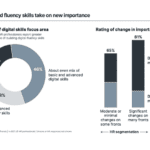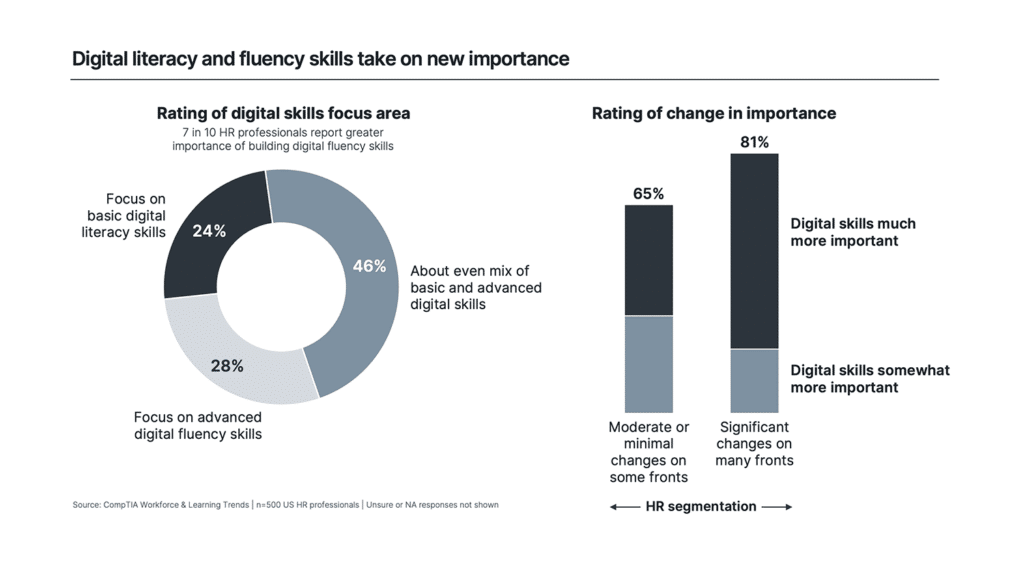Career development in America is broken.
Traditionally, employees earned a degree and went to work for an employer. If they did good work, they were promoted after three or so years of service. If their current employer didn’t have promotional opportunities available, employees either waited for new opportunities, plateaued or left to take a new position at another company, leading to a loss of talent for the organization and a new position to fill.
This arrangement is no longer working for either employees or employers.
Career development issues for employees
Degrees are becoming too expensive and increasingly not worth the time or money to employees, especially in a robust economy where they could earn more. Between 2000 and 2021, average college tuition and fees jumped by 65%; between 2010 and 2021 alone, tuition and fees rose by 17%. As a result, today, two-thirds of the working population don’t have college degrees, according to the U.S. Census Bureau.
Employees are also not eager to go into debt to pay for higher education. According to CNN Underscored, the average recent student loan debt in 2023 was $38,290 per student; aggregate education debt in the U.S. now exceeds $1.74 trillion. “Without a doubt, students are more reluctant to go tens of thousands of dollars into debt for a degree that doesn’t necessarily create a straightforward path to financial security,” says Gannon-Jones, vice president for content at Karat. “I don’t have a degree,” says Gannon-Jones. “I was a trade apprentice, and I’ve learned about technology, tech education, assessment and leadership through on-the-job work and being given an opportunity to learn and grow on the job.”
Meanwhile, the number of promotion opportunities is declining. In a survey of 700 organizations by The Washington Post, “43% reported they would have fewer opportunities to promote people in the years ahead” due to the flattening of organizational structures and the expanded use of technology. The number of employees who subsequently feel “stuck” and lack engagement in their jobs is a widespread problem, according to numerous studies, with anywhere from a fifth to 84% of employees claiming to be actively unhappy at work.
The vast majority of these employees are also considering quitting. Laments one factory worker: “I’ve been working in a factory for the past five years or so, and I don’t think there’s any likelihood of promotion any time soon. There aren’t any higher positions open; they’re all filled. I’ve been in the same entry-level job the whole time. At this business, the only time people get promoted is if someone in the chain of command leaves the business, and even then, the company prefers to hire someone new who already has management experience, rather that promote the lowest-level people. I don’t think anyone in the entire factory is getting promoted anytime soon.”
Today’s employees have greater expectations to learn skills as needed at work, with 74% of employees preferring to learn during their spare time at work, according to Linkedin’s Workplace Learning Report. Plus, around 73% of employees prefer to view online training content like short videos and quizzes from their personal devices, such as smartphones, as it is convenient for their schedules. The idea is that learning should always be available to them at their fingertips, whether they’re at home, commuting, standing in a queue or sitting in a coffee shop. Long story short: If millennials and Gen Z workers don’t feel their employers are investing in their education, training or development, they won’t stay.
Career development issues for employers
Increasingly, employers report that new hires lack the necessary skills for the job. According to LinkedIn, only 37% of employers feel that their entry-level employees have the necessary soft skills to do their jobs, while a recent World Economic Forum report found that 54% of all employees “will require significant reskilling and upskilling in just three years.”
Replacing employees who leave is increasingly difficult and can cost from one-half to two times the employee’s annual salary AND two years of lost productivity, says SHRM—and that’s if qualified candidates are even available. This problem will persist given that, according to the U.S. Department of Labor, 30% of the workforce will change jobs every 12 months.
According to the Deloitte Global Human Capital Trends Report, the No. 1 reason people quit their jobs today is the “inability to learn and grow.” In another study by the American Psychological Association, 91% of respondents say it is somewhat or very important to have a job where they consistently have opportunities to learn, even though only 47% say their employer offers educational opportunities.
Redefining career development
A better approach to dealing with employee shortages might be to plan to train, develop and keep every employee you currently have. Not having a college degree doesn’t mean employees aren’t qualified to do jobs that previously required that piece of paper. Employers can train employees for the role they need to fill more easily than ever—and degree-less employees can pursue the training for the field they want.
Continuing education courses, online classes, certification programs, boot camps and intentional upskilling efforts are popular and relatively inexpensive—especially compared to a four-year degree—to get up to speed on technology. These “new collar” employees can get a foot in the door with relevant skills.
I see three actions any company can take to tap into the value of career development for better engaging, developing and retaining employees:
- Focus on “just-in-time” skill development; that is, condensed training provided when it is most needed by employees
- Increase internal job mobility for all employees
- Enhance employee engagement to reduce employee turnover.
Focus on “just-in-time” skill development
Career development requires constant learning and application of skills. According to Forbes, some 97% of employers say soft skills are essential, and 85% of career success comes from having well-developed soft skills. However, a Workrowd survey found that only 31% of employers actually provide soft skills training to their employees. This needs to include asynchronous online training that can be completed at the employees’ discretion as their schedule permits.
Seventy percent of employees report that they don’t have mastery of the skills needed to do their jobs. More than 52% of workers admitted they need to learn new skills within the next year to continue their careers, according to the Harvard Business Review. However, most are unaware of the training resources their company or organization may offer.
Another strategy is “upskilling,” internal programs that teach new skills or upgrade existing skills for employees. The APA found that upskilled workers are more likely to report career advancement into a good job.
With an emphasis on learning, companies can create a more fluid, flexible workforce.
Deloitte found that skills-based organizations are 98% more likely to retain high performers and 57% more likely to anticipate change and respond effectively and efficiently. Skills-based companies also tend to adopt an approach where their primary focus lies on an individual’s specific skills, competencies and capacity, rather than traditional qualifications like degrees or work history. This paradigm shift prioritizes talent and ability over titles and hierarchies.
Increase internal job mobility for all employees
Once employees have developed new skills, those skills need to be used or lost. Only 12% of employees currently apply new skills learned in L&D programs to their jobs. Applying new skills needs to start with the employee’s current job but should not be limited to that. “To grow someone’s skills effectively, you need to provide them with assignments that stretch them,” says Jeff McHenry, PhD, an industrial-organizational psychologist. The organization also should help employees gain visibility throughout the organization to work with others and assist on projects related to their new skills.
Supporting the internal mobility of talent, such as through continuous learning, is good for employees and employers alike. It enables employees to continue to feel challenged and engaged with their work, acquire new skills, help fill organizational skills gaps and make progress toward broader career goals. Gartner has found that a lack of career opportunities is the main reason employees leave an organization.
To keep top performers, more companies today are also developing talent marketplaces, such as online portals and job boards where employees can see current openings, read job descriptions and better understand the organizational hierarchy and potential career paths. These tech tools allow employees to map out their personal career trajectories. “In the past, employees may have relied solely on a manager or mentor to help navigate their careers,” points out Tim McGonigle, vice president of HumRRO, a human resources research organization. “With a career-path system, employees have accurate, up-to-date information to do it themselves,” writes the APA.
Having a healthy system for employees to get feedback is also critical. This would include project debriefings in which employees take time to review work that was done with others to examine what went well, what could have gone better and suggestions for improving future assignments; a mentorship program for employees to get feedback from someone typically higher in the organization, who is not in the employee’s chain-of-command; as well as periodic “skip-level” meetings with one’s manager’s manager to discuss the employee’s career aspirations and strategies. New skills combined with visibility in the organization lead to new opportunities as the employee gets known by others throughout the company, including those above them in the organization.
Of course, a stated “hire-from-within” policy goes a long way to show employees that the company is serious about their advancement. An internal promotion—also called an “internal hire”—is when a company chooses to promote or transfer an existing employee into a new role. In addition to advancing a deserving employee, this also opens up additional opportunities for other employees to fill the newly opened positions that are created.
Enhance employee engagement to reduce employee turnover
PwC says the top two drivers of employee retention are recognition of one’s work and career development opportunities. LinkedIn research found that 94% of employees say they would stay at a company longer if it invested in their learning and development.
Employees expect continuous online education and training in addition to onboarding training. This is because they want professional growth and career advancement to stay relevant and current with their changing job role and industry, which becomes a hedge against being laid off.
Gartner advocates that “by investing in employee growth, companies can reduce costly turnover and increase job satisfaction among employees of all ranks.” According to Hanover Research, more than two-thirds of companies find that training relevance (70%) and career advancement/ development (67%) drive employee engagement through online learning solutions. The features of online training materials that most drive employee engagement are interactive content (46%), video content (45%), certificates (45%) and feedback/ recognition (35%).
All development is self-development
Ultimately, all development is self-development, which means organizations need to place the responsibility of learning and development squarely on their employees, who need to show interest in learning, developing their skills and advancing their careers. Without that interest and initiative, employees may become entitled, feeling the company owes them opportunities they haven’t shown they deserve.
The post Redefining career development: Skills, mobility and retention appeared first on HR Executive.

